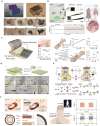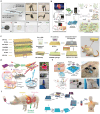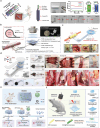Advances in Symbiotic Bioabsorbable Devices
- PMID: 39846424
- PMCID: PMC12199594
- DOI: 10.1002/advs.202410289
Advances in Symbiotic Bioabsorbable Devices
Abstract
Symbiotic bioabsorbable devices are ideal for temporary treatment. This eliminates the boundaries between the device and organism and develops a symbiotic relationship by degrading nutrients that directly enter the cells, tissues, and body to avoid the hazards of device retention. Symbiotic bioresorbable electronics show great promise for sensing, diagnostics, therapy, and rehabilitation, as underpinned by innovations in materials, devices, and systems. This review focuses on recent advances in bioabsorbable devices. Innovation is focused on the material, device, and system levels. Significant advances in biomedical applications are reviewed, including integrated diagnostics, tissue repair, cardiac pacing, and neurostimulation. In addition to the material, device, and system issues, the challenges and trends in symbiotic bioresorbable electronics are discussed.
Keywords: biodegradable materials; biotherapeutics; symbiotic bioabsorbable devices.
© 2024 The Author(s). Advanced Science published by Wiley‐VCH GmbH.
Conflict of interest statement
The authors declare no conflict of interest.
Figures





















References
-
- Lacour S. P., Courtine G., Guck J., Nat. Rev. Mater. 2016, 1, 16063.
-
- Ryu H., Seo M.‐H., Rogers J. A., Adv. Healthcare Mater. 2021, 10, 2002236. - PubMed
Publication types
MeSH terms
Substances
Grants and funding
LinkOut - more resources
Full Text Sources
